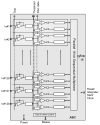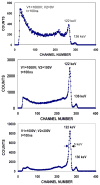Photon Counting Energy Dispersive Detector Arrays for X-ray Imaging
- PMID: 19920884
- PMCID: PMC2777741
- DOI: 10.1109/TNS.2009.2013709
Photon Counting Energy Dispersive Detector Arrays for X-ray Imaging
Abstract
The development of an innovative detector technology for photon-counting in X-ray imaging is reported. This new generation of detectors, based on pixellated cadmium telluride (CdTe) and cadmium zinc telluride (CZT) detector arrays electrically connected to application specific integrated circuits (ASICs) for readout, will produce fast and highly efficient photon-counting and energy-dispersive X-ray imaging. There are a number of applications that can greatly benefit from these novel imagers including mammography, planar radiography, and computed tomography (CT). Systems based on this new detector technology can provide compositional analysis of tissue through spectroscopic X-ray imaging, significantly improve overall image quality, and may significantly reduce X-ray dose to the patient. A very high X-ray flux is utilized in many of these applications. For example, CT scanners can produce ~100 Mphotons/mm(2)/s in the unattenuated beam. High flux is required in order to collect sufficient photon statistics in the measurement of the transmitted flux (attenuated beam) during the very short time frame of a CT scan. This high count rate combined with a need for high detection efficiency requires the development of detector structures that can provide a response signal much faster than the transit time of carriers over the whole detector thickness. We have developed CdTe and CZT detector array structures which are 3 mm thick with 16×16 pixels and a 1 mm pixel pitch. These structures, in the two different implementations presented here, utilize either a small pixel effect or a drift phenomenon. An energy resolution of 4.75% at 122 keV has been obtained with a 30 ns peaking time using discrete electronics and a (57)Co source. An output rate of 6×10(6) counts per second per individual pixel has been obtained with our ASIC readout electronics and a clinical CT X-ray tube. Additionally, the first clinical CT images, taken with several of our prototype photon-counting and energy-dispersive detector modules, are shown.
Figures


















References
-
- Johns PC, Dubeau J, Gobbi DG, Li M, Dixit S. Photon-counting detectors for digital radiography and X-ray computed tomography. SPIE. 2002;TD01:367–369.
-
- Shikhaliev PM, Tong X, Molloi S. Photon computed tomography: Concept and initial results. Med Phys. 2005;32(2):427–436. - PubMed
-
- Maidment A, Ullberg C, Lindman K, Adelow L, Egerstrom J, Eklund M, Francke T, Jordung U, Kristoffersson T, Lindqvist L, Marchal D, Olla H, Penton E, Rantanen J, Solokov S, Weber N, Westerberg H. Evaluation of a photon-counting breast tomosynthesis imaging system. Med Imag 2005, Proc SPIE. 2005;5745:572–582.
-
- Lundqvist M, Cederstrom B, Chmill V, Danielsson M, Hasegawa B. Evaluation of a photon-counting X-ray imaging system. IEEE Trans Nucl Sci. 2001;48:1530–1536.
-
- Chmeissani M, Frojdh C. First experimental tests with a CdTe photon counting pixel detector hybridized with a Medipix2 readout chip. IEEE Trans Nucl Sci. 2004;51:2379–2385.
Grants and funding
LinkOut - more resources
Full Text Sources
Other Literature Sources
Miscellaneous
